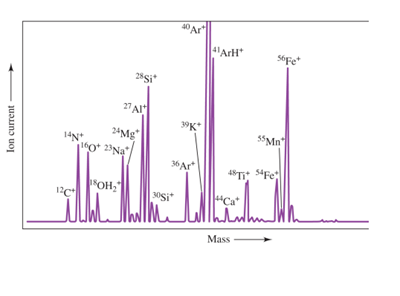Unit 7- Mass Spectrometry
1/35
There's no tags or description
Looks like no tags are added yet.
Name | Mastery | Learn | Test | Matching | Spaced |
|---|
No study sessions yet.
36 Terms
explain basic principle of MS
A mass spectrum is a plot of ion abundance versus mass-to-charge ratio or just mass for singly charged ions. ( used to identify MASS of molecules)
—> will produce a mass spectrum

explain overview of how MS works
1. Analyte is converted to ions by applying energy (create charged particle)
2. Ions formed are separated based on their mass to charge ratio
3. Ions are directed to a transducer that converts the number of ions into an electrical signal
when can mass to charge be shorten to mass
only for singly charged ions
Atomic mass scale
used to express atomic and molecular masses based on specific isotope of carbon
unified atomic mass unit
exact mass
refers to the precise mass of a specific isotope of an element or compound that contains particular isotopes.
Average atomic mass
the weighted average of the masses of all naturally occurring isotopes of an element, considering their fractional abundances.
what are the different components of MS
inlet system
ion source
mass analyzer
detector
signal processor
readout
what are the different types of Mass analyzers
magnetic
double focusing
quadrupole
ion trap
ion cyclotron
time of flight
what are double focusing MS
elector sector procedes magnetic sector
—> focus beam of ions
A double focusing mass spectrometer uses two types of analyzers in sequence:
Electric field (electrostatic sector)
Magnetic field (magnetic sector)
how does quadrupole work
mass filters that only allow ions of a certain mass-to-charfe ratio to pass
—>scan voltage applied to the rods
—> low resolution
Time of flight?
of mass analyzer that separates ions based on how long they take to travel down a flight tube to the detector after being accelerated.
what are the different ion sources for MS
ICP —>Q
direct current plasma—>Q
microwave induced—>Q
sparked—> DF
glow discharge—>DF
hwo does ICPMS work
Ions formed in the plasma are introduced into the mass analyzer, often a
quadrupole, where they are sorted by m/z ratio and detected
what is sparked source MS
used for solid samples, not easily dissolved by ICPMS
how are analyte ions drawn into the MS
differential pumping—>
what are the different ion sources
gas=phase: EI, CI
Desorptopn: FAB< MALBI< ESI
explain gasp=phase source of ions
sample is vaporized and ionzied
explain desorption
sample in a solid or liquid state is converted directly into gaseous ions
works by nonvolatiles and unstable soucre
what is energy ionization
molecules bombarded with high energy beam of electrons
positive ions—> electrostatic repulsion
what are inlet systems used for
to introduce a representative sample to the ion source
with minimal loss of vacuum
what are the different types of inlet sources
batch inlets, direct probe inlets, chromatographic inlets, and electrophoretic inlets.
BDEC
what mass analyzer used in GC/MS
quadrupole
what is tandem ms
do ms twice use two mass analyzers
explain ms-ms
ms 1 produces fragment ion
precurose ion reacts
decomposes to product ions
product ions gets ms 2
applications of MS
molecular mass
fragmentation patterns
identity based on comparing to data
pesticides in foods
structures of compounds
what is a good technique for non volaties
LC/MS
what is a sector analyzer
Separation in these devices is
based on their deflection of ions in
a magnetic field
general design of MS
Inlet: interface with GC, LC, IC, CE.
Ion source: region in a mass spectrometer where gas-phase ions are
produced
Mass analyzer: region in a mass spectrometer where ions are separated
according to their mass-to-charge ratio (m/z) values
Detector: collect and convert ions (with a particular m/z) into an electrical
signal by an ion transducer.
Vacuum pumps keep the mass spectrometer devoid from interferences
A computer usually pilot the system, collect the data (e.g. mass spectrum)
and allow for their analysis (qualitative or quantitative).
what can teh mass analyzer do
continously look for signal over m/z range
ook at specific m/z
what is precursor ion
selected frgament in the first mass analyzer
what is daughter ion
fragmenattion of precursor
Parent daughter ion
Q1>Q3
Resolution in MS?
Ability to distinguish two peaks of a mass spectrum with a difference
of mass-to-charge ratios ΔM
what mass analyzer lowest resolution
quad
highest resolution MS
time of flight